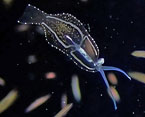| Home |
| Acknowledgments |
| Conventions |
| Glossary |
| Maps |
| References |
| Links |
| Articles |
| Thumbnails |
| Species
list |
| Family |
| Next
species |
Additional Photos

marginal spots

Phylliroe bucephala Lamarck, 1816

| Maximum size: ( ) Identification: The body of this species is elongate and streamlined, tapering to a slightly expanded "tail." On the head are two long rhinophores. The reproductive and digestive glands can be seen through the transparent body. Its broader profile and longer rhinophores distinguish it from Cephalopyge trematoides. A few iridescent-white spots may be present along the dorsal and ventral margins. Natural history: Phylliroe bucephala is a pelagic species that is rarely seen in near-shore waters at night. Young animals feed on the hydromedusa, Zanclea costata attaching themselves to the bell of the medusa by their pedal gland. Adults swim by means of lateral undulations. They may feed on hydromedusa, siphonophores and larvaceans. They are also bioluminescent. (Lalli & Gilmer, 1989) (Note 1) Distribution: Big Island and Oahu: circumtropical. Taxonomic notes: It was first recorded in Hawaii off the Kona Coast of the Big Island by Joe Weston. Photo: Joe Weston: 3 miles off the Kona Coast, Big Island; 12 m (40 ft); at night. Observations and comments: Note 1: For a video of one swimming (by Pam Madden) click here. |
| Thumbnails |
Species
list |
Family | Next species | Top |